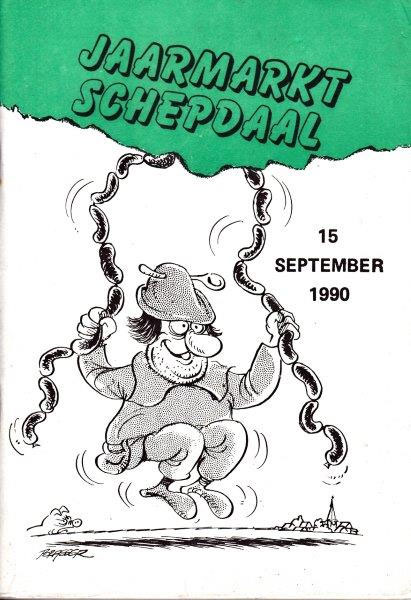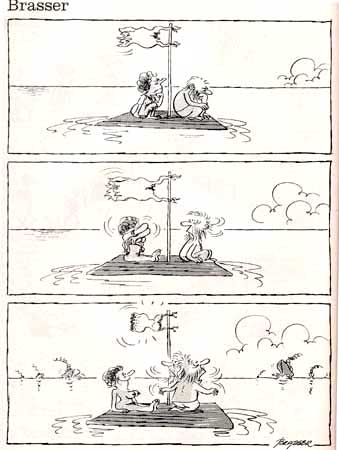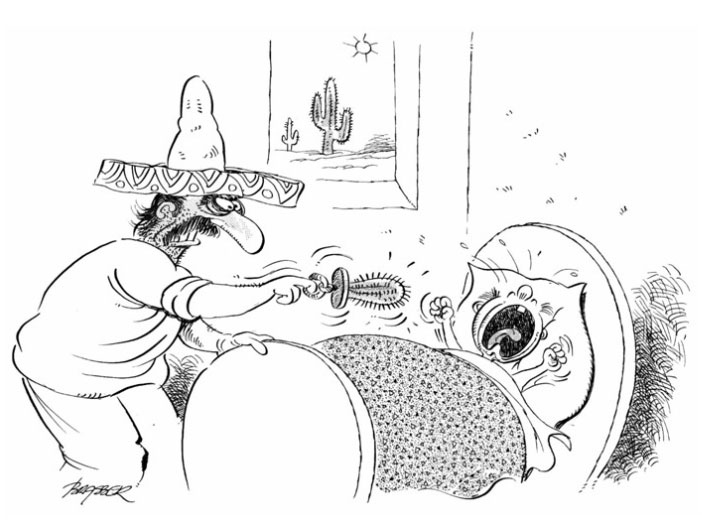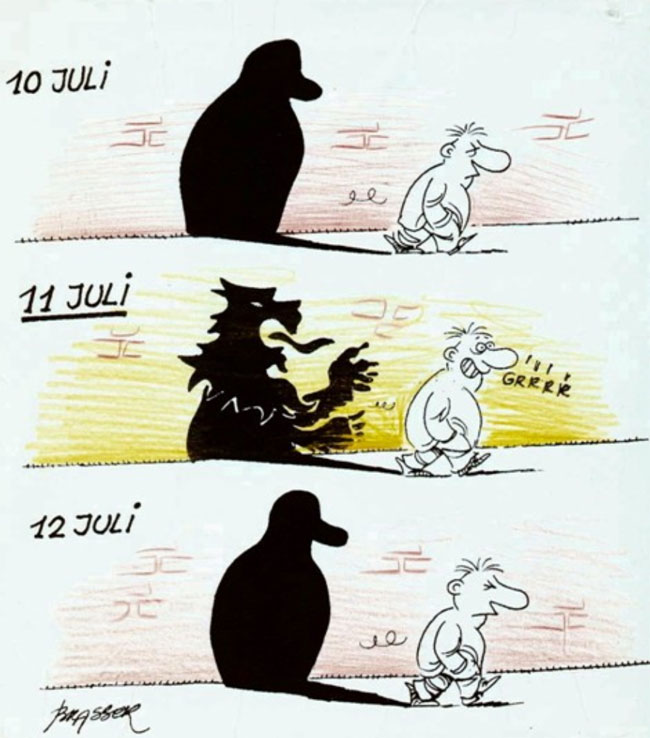Cartoon by Brasser. Translation: "I'm a Fleming." - Doctor: "I'm sorry, I can't cure that."
Brasser was a late 20th-century Flemish cartoonist, best known as the house cartoonist for the right-wing satirical weekly 't Pallieterke for nearly half a century (1962-2001). His daily current events cartoon, 'PRIK' (1975-2000), could be read in Het Nieuwsblad and De Gentenaar. A productive cartoonist, Brasser made thousands of cartoons about politics, sports events and more non-specific gags. His work was published in many countries, ranging as far as Japan. Throughout his long career he won many awards.
Early life and career
Pol de Valck was born in 1937 in Humbeek in the province Flemish Brabant. He loved drawing from an early age and was 13 when he made his own cartoon magazine: Kinderland. Between 1950 and 1953, he created about 47 issues. During his military service he published cartoons in the army magazine March, which he continued to do even after returning to civilian life. De Valck studied graphic arts in Molenbeek. He began his career as a photo and film retoucher in a printing firm, ASAR, in Anderlecht. Later he became a graphic editor and journalist for the KWB and the KAJ until 1996. De Valck remained active as a cartoonist for the towns of Humbeek and Schepdaal. In Schepdaal, he made cartoons for the school De Klimop, even designing its official logo in 1990. He created the mascot of the local annual market too, nicknamed "Het Brasserken".

The "Brasserken" character on a poster for the Schepdaal annual fair.
Cartooning career
In May 1962, De Valck published his first cartoons in the satirical, right-wing conservative weekly 't Pallieterke. He used the pseudonym Brasser, referring to the nickname of people from Humbeek - "brassers" -, meaning people who enjoy partying, drinking and eating. Brasser was a mainstay in 't Pallieterke for nearly 50 years, creating thousands of drawings for the publication. It led to more assignments for Catholic and/or Flemish-nationalistic magazines, such as Wij, the home magazine of the Flemish-nationalistic party Volksunie. Besides cartoons he also contributed a stop comic, 'Juan de Anarchist'. Brasser's work could also be read in Doorbraak, Het Volk, De Volksmacht, Raak, Randkrant, De Brusselse Post, Fladder, TV-Express and Jan Bucquoy's Spetters. He contributed to several publications of the Catholic Worker's Youth movement (KAJ), such as Bevrijding, Keerom, Mardijck and Akzie.
To most people, Brasser was particularly known as the creator of 'PRIK', a current events cartoon which ran on the front page of Het Nieuwsblad, De Standaard and De Gentenaar from February 1975 until June 2000. The same papers also published his cartoon panels 'schaVOTjes', 'GRAFiekjes', 'Beknopt Verslag' and 'Brasserie', while his cartoons about association football matches, cycling events and the Olympic Games livened up the sports pages. Brasser also illustrated Gaston Durnez' column 'Courant' in the newspaper De Standaard.
Gag published in Spetters.
Most of Brasser's cartoons referred to late 20th-century national, political, social, cultural and sports events. But he also made cartoons about more general and timeless topics, such as his famous advertisements to discourage smoking. Brasser made several gag comics about straightforward humorous situations, such as executioners, people on deserted islands, nagging housewives and disobedient husbands. Since he made several pantomime cartoons, it allowed for easy worldwide distribution, among others in the Netherlands, the United Kingdom, France, Greece, Poland, the United States, South Korea, South Africa and Japan.
TV career
Brasser's cartoons were used as the basis for the TV sketch series 'Oei!' (1989) on the Flemish public channel BRT (nowadays Eén). For the same sketch show, Ian (Jan De Graeve) also made animated intermezzos. Brasser and Emiel de Bolle co-hosted the TV show 'Pen & Streek' (1996-1999) on Ring-TV, the regional network broadcasting in the Belgian province Flemish Brabant. Every Friday one of them made a cartoon live in the studio.
Cartoon by Brasser.
Recognition
Brasser's work was often awarded. In 1968, he won the Audience Award at the International Cartoonale in Beringen. He won the Japanese award Yomiuri Shimbun twice. In 2006, he was posthumously named honorary citizen of Grimbergen.
Legacy and influence
Brasser died in 2001 after a long illness, at the age of 64. André Nollet succeeded him as house cartoonist in 't Pallieterke. A fanclub, de Brasservrienden, has kept Brasser's memory alive by organizing exhibitions and special events. A local restaurant in Kruishoutem, de 'Brasserie', was named after him and in 2006 he received his own bust in Humbeek. In 2018 his character "het Brasserke", a mascot for many local organizations, received a small statue in Schepdaal, not far from where the cartoonist used to live. Brasser was a major influence on André Nollet, Marec and Canary Pete.
Books about Brasser
For people interested in Brasser's life and career, the book 'Brasser - Leven en Werk' (Brasser, 2016) is highly recommended.
Cartoon commenting on the fact that most Flemish-nationalists only feel passionate about "being Flemish" on the Flemish-national holiday on 11 July.






